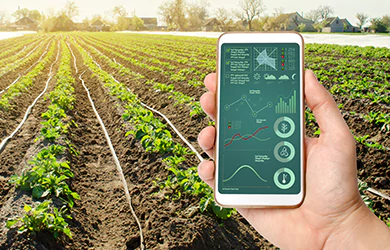5 Ways Farm Analytics is Powering the Progress of Agribusinesses

In recent times, big data and analytics have made headlines across the globe for their ability to create and transform industries, drive efficiencies, and improve operational costs. As the proliferation of IoT and sensors continues to generate large chunks of data in real-time, various industries and tech-oriented companies are adopting new technologies such as Artificial Intelligence (AI) and Machine Learning (ML) to turn these data into useful information. The agriculture sector has been no exception to this trend.
The transformative age has arrived for farming. Earlier, when people used to think of farms, ‘data’, ‘connectivity’, and ‘analytics’ were not likely the terms that came to mind. However, with billions of mouths to feed in the coming decades, integrating these elements in day to day agriculture activities has become imperative. In this article, we explore the growing significance of farm analytics in making agriculture functions more precise and productive.
Implementation of Farm Analytics in Agriculture
Technological advancements in data-driven agriculture are increasingly solving global problems, especially in areas where farming is a means of survival and the farmers struggle with environmental and climate factors leading to crop losses. To counter these pressures, industry leaders and policymakers are seeking assistance from modern technology forces such as Internet of Agricultural Things (IoAT) and big data along with cloud computing and farm analytics.
The first phase of this process is data collection through sensors plugged in trucks and tractors, as well as in fields, soil, and plants. Farm analytics integrate these large amounts of data with other information such as weather conditions and pricing models available in the cloud to bring multiple data sets together in a single structure.
This creates the opportunity to compare, track trends, and find unique patterns in the data to help identify lucrative opportunities. Moreover, these insights assist in pinpointing existing issues such as operational inefficiencies, shortage of resources and assist in formulating predictive algorithms that can alert the farmers before a problem occurs.
Practical Applications of Farm Analytics in Agricultural Practices
In farm analytics practices, farm analytics help farmers make more informed decisions, save costs, and grab new business opportunities. Here are the key possibilities that come with the use of farm analytics in the agriculture sector:
1. Meeting the Growing Food Demand with Increased Productivity
Today, soil sensors, GPS-equipped tractors, and weather stations give unprecedented visibility into farm operations and provide excellent opportunities to agribusinesses. This enables the use of already existing farmland more efficiently rather than using more land and resources with the purpose to increase yields.
Farm analytics provides insightful crop data, enabling farmers to make informed decisions on the type of crop to grow based on atmospheric conditions, rainfall patterns, and type of soil to make a profitable harvest. A better understanding of these patterns also helps in procuring seeds that can survive under the existing climate, temperature, and soil conditions.
2. Predicting Diseases and Optimizing Use of Pesticides
Several risks involved in farming and agriculture are outside of farmers’ control, especially pest infestations and crop diseases. Experienced farmers can spot signs of failing crops but it is often too late to do anything. With farm analytics, it is now possible to track signs of crop diseases as well as predict pest threats based on past and current harvests.
In the subsequent phase of pest management, the administration of pesticides has been a key issue, considering its side effects on the ecosystem and soil fertility. Farm analytics enables smart and precise application of pesticides at specific times and locations, helping food producers avoid the overuse of chemicals and thereby preventing any damage to the soil or crops.
3. Understanding Environmental Challenges
As weather conditions become unpredictable and natural disasters such as drought and severe storms that have a direct impact on agriculture become more frequent, farmers are likely to face more challenges in the coming decades. This will not only affect the crop outcomes but will also compel food producers to constantly keep altering their processes.
However, using farm analytics can help navigate shifts in environmental conditions that will enable farmers to be prepared for challenges and make evidence-based resource management decisions. As a result, agribusinesses will have all the essential data to predict weather events beforehand and employ effective climate-smart agriculture practices for better outcomes.
4. Managing and Improving Supply Chain Operations
The current supply chain of agribusiness needs improvements in both communication and collaboration efforts. Studies have shown that a vast portion of food produced for human consumption is lost or wasted every year in the world. Food waste causes economic losses, harms natural resources, and worsens food security issues.
Farm analytics can also be used to optimise various administrative activities such as supply chain operations and waste management. Big data analytics helps farmers achieve supply chain efficiency through tracking and optimisation of delivery truck routes. This not only improves food delivery cycles but allows farmers to communicate valuable information with distributors and retailers regarding agriproduct quality.
5. Enabling Long-term Analysis for Better Operations
Farm analytics analyses decades of crop data that help farmers efficiently estimate the number and state of crops produced even before planting the seeds. This further enables better crop planning and leveraging of various farming factors to maximise crop production in the shortest time possible.
Moreover, data gathered throughout previous farming, harvesting operations and food delivery cycles can suggest improvements to accommodate changing conditions effectively. Insights into food production provided by farm analytics can further help customers establish confidence in food safety and security.
Agriculture driven by farm analytics boosts food production and helps fight several agricultural challenges such as pest infestations, a gap between supply and demand, and food waste. So, how can agribusinesses obtain all these benefits offered by farm analytics? FarmERP is capable of processing and analysing various farm data, both past and current, that help visualise desirable outcomes and provide solutions for existing challenges. Contact us today to know how we can help you achieve your agribusiness goals.
